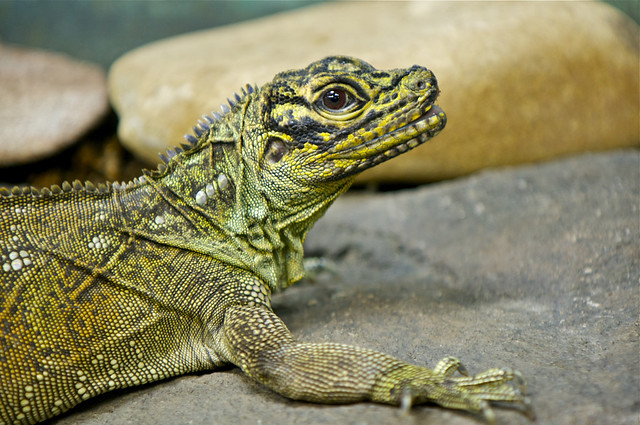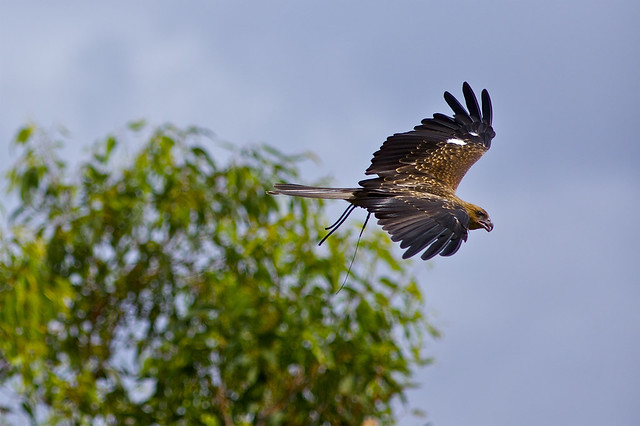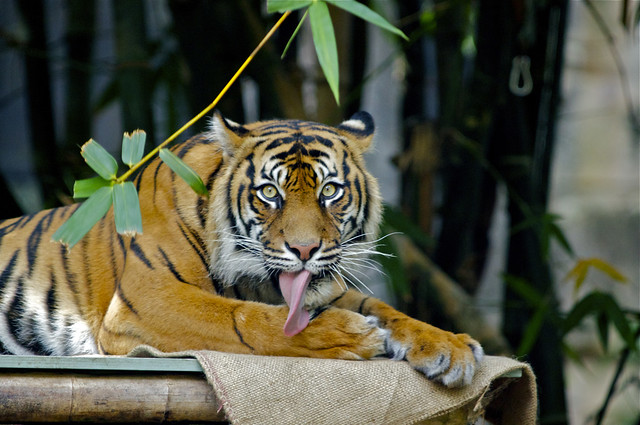Technical: 34°-12° full frame, 23°-8° APS-C; p blades, circular aperture; min. focal length 910mm; filter size 77mm; physical length 198mm; weight 1598g.


Three 'hold' buttons can fix focus or other attributed functions. On the side the switches are to choose AF/MF, standard or full-time DMF (Direct Manual Focusing) and a focus limiter for 3m to infinty or the full range of the zoom.

EXIF 1/60 sec, f/2.8, 200 mm, ISO 500, 2011:03:18 16:16:15, SLT-A55V
1. (1024 x 680) Dragon
EXIF 1/320 sec, f/2.8, 200 mm, ISO 1600, 2011:03:18 15:52:29, SLT-A55V
2. (1024 x 680) Duck
EXIF 1/320 sec, f/2.8, 200 mm, ISO 800, 2011:03:18 16:09:29, SLT-A55V
3. (1024 x 680) Eastern Water Dragon
EXIF 1/3200 sec, f/3.2, 180 mm, ISO 100, 2011:03:18 15:02:42, SLT-A55V
4. (1024 x 682) Whistling Kite (raptor)
EXIF 1/1600 sec, f/2.8, 70 mm, ISO 1600, 2011:03:18 14:36:12, SLT-A55V
5. (1024 x 680) Sumatran Tiger
EXIF 1/800 sec, f/2.8, 200 mm, ISO 1600, 2011:03:18 14:38:35, SLT-A55V
6. (1024 x 680) Sumatran Tiger
EXIF 1/2000 sec, f/2.8, 200 mm, ISO 1600, 2011:03:18 14:33:58, SLT-A55V
7. (1024 x 680) Sumatran TigerThe weight does not seem so dramatic after the 135mm Zeiss which is all glass and metal. The 70-200 has plastic casing (presumably to save weight) while the lens body is made from metal, according to Photozone, "the build quality of the lens is exceptional" . It comes with a lens-hood of exaggerated proportions with a neat hatch that can be opened to access polarising filters. There are 3 focus-hold buttons on the lens itself and an optional tripod mount. The three buttons can be assigned to different tasks. I think I will designate one for AEL-hold, one for AF-hold. I took off with no filters, Kelvin adjustments or even the lens-hood and, given the crowded environment, no tripod. This was an ambitious test for the handheld capabilities of such a zoom lens. Tripod and cable release will prevail next time for a fairer comparison with the 135mm.
Naturally I compare the 70-220G against the Zeiss 135mm f/1.8 because it is my next longest lens, however the 70-200 might be prioritised for wildlife photos. First impressions reviewing on the LCD screen can be deceiving and I was worrying a lot that the sharpness was not matching that of the Zeiss that I am accustomed to. In part, this might be because the less bright and contrasty, less warm colour temperature provoked initial suspicion. I would not say I had a profound 'hit-rate' with keepers but I also changed my habits to try to track birds in flight, the Sumatran tiger pacing incessantly and never stationary, a slower lens than the f/1.8 135mm or f/1.4 85mm handheld and sometimes therefore resorting to a higher ISO or rapid-burst multi-exposures. It is difficult to track a subject's eye with the same precision using this method, leaving more discretion to the camera and chance. The first and striking feature is the incredible quietness and super speediness of the SSM focus motor. According to Photozone, "It is fast (although not as fast as in the Zeiss ZA 24-70mm f/2.8), near silent and very accurate". This only makes me more keen to spend time with my 24-70! There were occasional instances of focus 'hunting' in low light but never accompanied by intrusive lens noise and, for focusing in normal lighting conditions, it was almost instant: even the shutter noise seemed baffled by the large plastic lens. Altogether, these are very pleasing characteristics for nature photography. The zoom ring and focus ring are quite tight but perhaps that loosens with use. The lens does not change length with zooming, so there are no 'lens creep' issues. The front element does not rotate due to the internal focusing mechanism (WRT polarisers).
Convinced that the 70-200G might not be as precise as the Zeiss, I decided to perform some test shots at 135mm focal length. This is not a 'fair' test in the sense that the 135mm Zeiss is a fixed prime, but the 70-200G was therefore not at its extreme soft end of the zoom either. I compared same 'real-life' daylight conditions on P setting in late afternoon and both lenses opted for their widest aperture meaning, again, the exposures were not exactly the same: 2.8 and 1.8, respectively. In 50% of instances, the 70-200 was sharpest and in 50% the 135mm prime was sharpest, so I chalk that up as more or less equally sharp, (a bonus for the zoom) and variations in user operation or precision in focusing. The DOF was slightly different which is unsurprising given the 1-stop difference in aperture. The colour temperature was dramatically different: warmer on the Zeiss. This phenomenon is widely reported but also I had the B+W Kaeseman Circular Polarising (MRC Schott glass) filter on the Zeiss which further exaggerates the vivid reds. So, being able to explain away and control things like sharpness, DOF, and at least adjust for colour temperature, the lenses so far performed equally well. Photozone, testing from charts in controlled lab conditions, writes, "The Sony G produced very good to excellent resolution figures in the MTF lab. The performance is best at 70mm with a generally excellent quality across the image field".
70-220G f/2.8 1/320 200mm crop centre-weighted metering, AF & 135mm f/2 1/60 135mm centre-weighted metering, AF.
Seems 70-200G crop is sharper. Click for full-size image.
70-220G f/2.8 1/800 135mm centre-weighted metering, AF & 135mm f/2 1/50 135mm centre-weighted metering, AF.
Seems 135mm is sharper. Click for full-size image.
70-220G f/2.8 1/250 135mm centre-weighted metering, AF & 135mm f/2 1/250 135mm centre-weighted metering, AF.
Seems 70-200G is sharper. Note different bokeh in each image. Colour due to CP filter. Click for full-size image.
Very distinctive, however, was the different bokeh (blurred out-of-focus parts of the images). While the Zeiss has a renowned, smooth, silk bokeh without any signs of sharp-edged circles or bright highlights nor distinctive shapes, the 70-200G has a rather abrasive, strident bokeh, at times decidedly distracting. This is less of an issue if skylight or bright contrast behind the subject can be eliminated. The Whistling Kite example (the raptor pictured above) shows how strange this bokeh can look. These pictures of the tiger and kite were taken at high shutter speeds and high ISO so next time I will try stopping down or at least bringing the ISO back to earth but it was a very dim overcast day on this occasion (by Australian standards, anyway) and I was using a rapid-burst camera mode. Photozone writes, "Out-of-focus highlights are circular but show a fairly obvious outlining at f/2.8 and busy backgrounds are not handled overly well. The situation improves when stopping down". In contrast, Kurt Munger writes, "The Sony 70-200mm F/2.8 has excellent bokeh, and doesn't seem to vary from different focal lengths. Very pleasing even stopped down". I can only assume that 'very pleasing' means it is a bright fast lens and therefore is capable of producing bokeh in a range of situations, however, the 'pleasingness' I am comparing to the smoothest possible when speaking of the favourable bokeh of Zeiss lenses. This is good news! While I am not excited by the 70-200G bokeh, the most trusted Sony reviewer reports that it fares well: phew! Nonetheless, I will try stopping down more, light permitting. Looking at Munger's sample pictures, they are very different to mine with seriously decent bokeh at f/2.8. The sample picture here of a kind of rainbow pigeon (at least that's what it sounded like, I'm sorry I don't know bird species) is a picture in which the eye is tack-sharp and the colour rendition true, but the bokeh of the (admittedly difficult backlit) subject is unacceptably defined for my taste. It is the combination of brightness and sharp-edged circles in the background that bother me.
The picture of Red-Tailed Black Cockatoo (Calyptorhynchus banksii) [know these guys: they're Australian native birds!] is also shot in awkward conditions - 1/2000 ISO250 f/2.8. I would prefer a shallower DOF and smoother bokeh to really differentiate between the sharp subject and blurry background, whereas the background still has too much clarity in this shot (but they do fly fast - my excuse ...). Here's one of my all-time favourite bird photographers, Bence Mate, who hangs out in hides for months at a time to capture his ideal shots. For that patience (and great skill) he won the Wildlife Photographer of the Year Award 2010. I guess everybody has seen his picture of leaf-cutter ants in Costa Rica by now. He says he took thousands of pictures, from which this one was selected.
Compared with the 85mm Zeiss, any magenta fringing is far more difficult to detect (though not invisible) yet outclassed by the Zeiss 135mm which truly has next to no colour aberration. Kurt Munger writes, "Nice color rendition, reasonably sharp wide open and very sharp from f/4 down, instant auto-focus over-ride, very quiet and accurate focusing." As he points out, this is the sort of lens worth paying for if you undertake handheld wildlife photography. In my experience, wildlife photography can often be handheld for the simple reason that you need to quickly track an animal, a situation in which it's hard to keep up with a tripod. More time will tell ...








